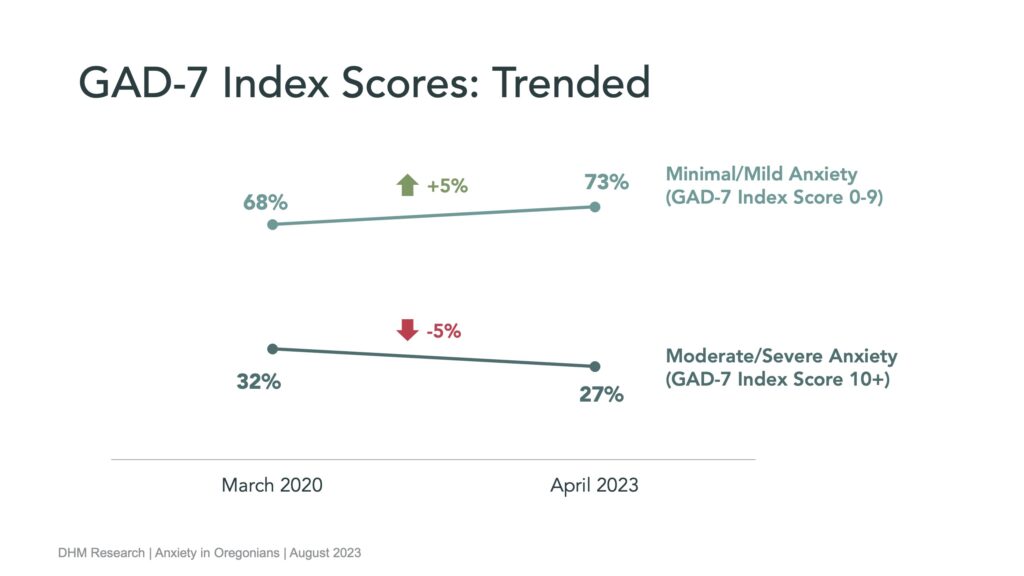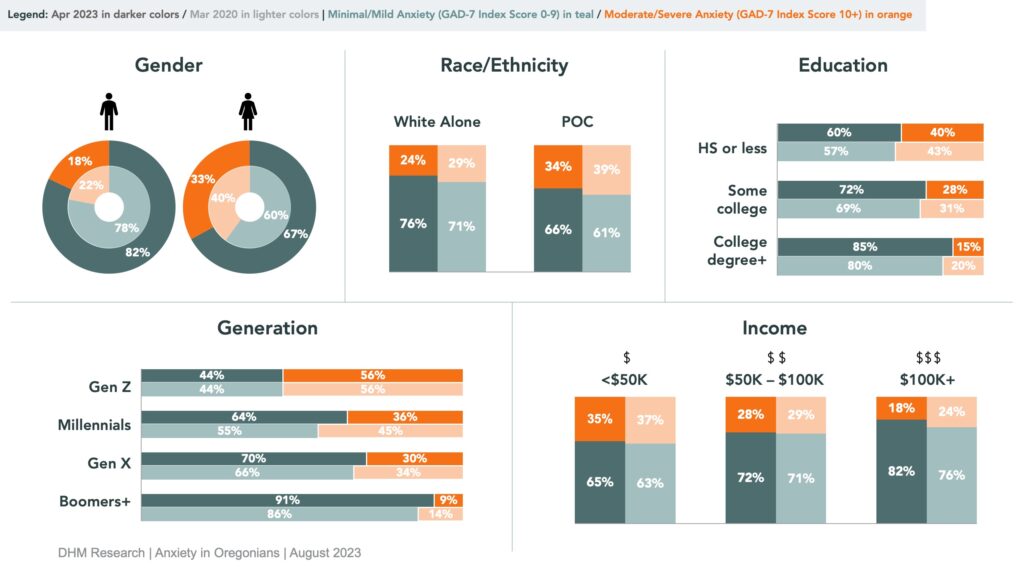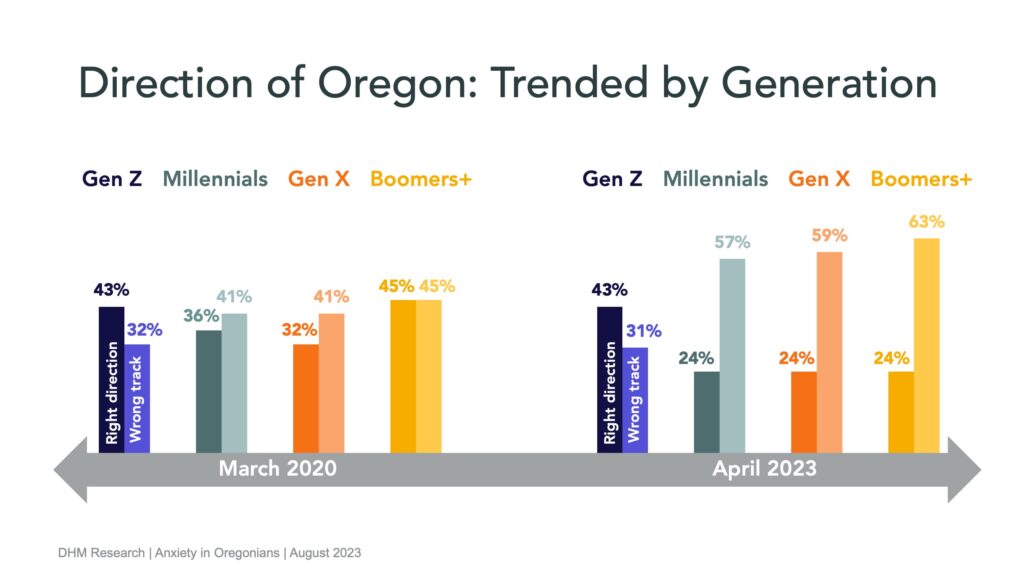In surveys conducted in March 2020 and April 2023, DHM Research included a screening tool for generalized anxiety disorder, called the Generalized Anxiety Disorder 7-item (GAD-7). Incorporating this screening tool allows us to assess anxiety levels in Oregonians over time and among different demographic groups, as well as how anxiety levels correlate with statewide public opinions.
In March 2020, 68% of Oregonians experienced minimal or mild anxiety, with 32% experiencing moderate or severe anxiety. Considering the context of a global pandemic, economic downturns, and mounting social unrest, it stands to reason that about 1 in 3 Oregonians screened for clinical levels of anxiety at the time. Over the past 3 years as the world has started to rebalance, so too has Oregonians’ anxiety. In April 2023, 73% of Oregonians had minimal or mild anxiety, with 27% having moderate or severe anxiety.

Anxiety levels are consistently higher among women, Gen Z, People of Color (POC), and Oregonians with lower education and income levels compared to their subgroup counterparts in both 2020 and 2023. Though the base sizes are very small, it is also relevant to note that the majority (n=13 out of base n=15) of Oregonians who identified as transgender, non-binary, or gender non-conforming in our 2020 and 2023 surveys were screened into the moderate/severe anxiety categories.

Gen Z may be anxious, but they are hopeful. Oregonians in Gen Z are not only more anxious than their generational counterparts, but they also held on to their level of anxiety over time (56% moderate/severe anxiety in both 2020 and 2023 vs. a 4%–9% drop in all other generations between 2020–2023). However, they also held on to their optimism when asked about the direction they see the state headed compared to older generations. 43% of Gen Z see Oregon as headed in the right direction in both 2020 and 2023, while all other generations are more likely to say Oregon is on the wrong track in 2023 compared to 2020.

In DHM’s April 2023 survey, we included a variety of policy and public opinion questions on the topics of immigration, foreign trade, and transgender issues. While the GAD-7 was designed to screen for generalized anxiety, it can also be used to screen for other common anxiety disorders (Panic Disorder, Social Anxiety Disorder, and Posttraumatic Stress Disorder)1.
Looking at differences in opinions between those with minimal/mild anxiety vs. those with moderate/severe anxiety, we can understand policy attitudes of Oregonians with clinical levels of anxiety and begin to see distinct opinions emerge. Though those with moderate/severe anxiety are more likely to include Gen Z, women, and POC, all of whom are more likely to lean Democratic, there are no significant differences by political party among those with moderate/severe anxiety (29% Democrat, 29% NAV/other, 20% Republican). That is, political affiliation is likely not driving the differences we observe within this group. This establishes those with moderate/severe anxiety as their own distinct subgroup.
The following are a few key policy attitudes among Oregonians with moderate/severe anxiety:
Immigration
- More likely to think immigration should increase (33% vs. 23% of total Oregonians)
- Would say illegal immigration is a small problem or not a problem (52% vs. 44% of total Oregonians) opposed to a very or somewhat serious problem
- Support Oregon’s status as a sanctuary state (65% total support vs. 54% of total Oregonians)
Foreign trade
- More likely to think trade between the United States and foreign countries has been equally positive and negative for the community where they live (44% vs. 34% of total Oregonians), for the United States (32% vs. 25% of total Oregonians), and for foreign countries that trade with the United States (34% vs. 27% of total Oregonians)
Transgender issues
- Agree that someone can be a different sex than the one they were assigned at birth (57% vs. 46% of total Oregonians)
- More likely to feel our society has not gone far enough to accept people who are transgender (48% vs. 35% of total Oregonians)
- Strongly support protecting transgender individuals from discrimination in jobs, housing, and public spaces such as restaurants and stores (61% vs. 48% of total Oregonians)
- Oppose making it illegal for public school districts to teach about gender identity in elementary schools (54% vs. 47% of total Oregonians)
- More likely to support requiring health insurance companies to cover medical care for gender transitions (47% vs. 42% of total Oregonians)
- More likely to support requiring the Oregon Health Plan to cover medical care for gender transitions (44% vs. 40% of total Oregonians)
Footnotes
1https://www.hiv.uw.edu/page/mental-health-screening/gad-7
